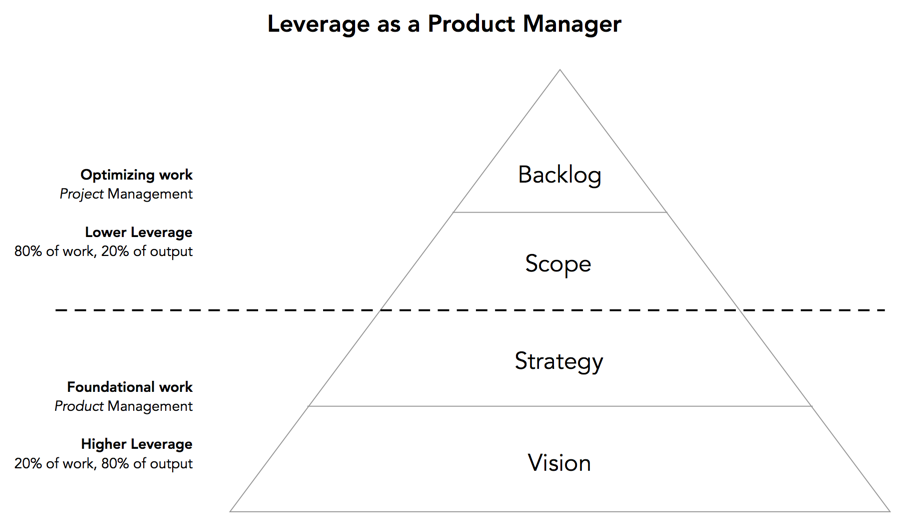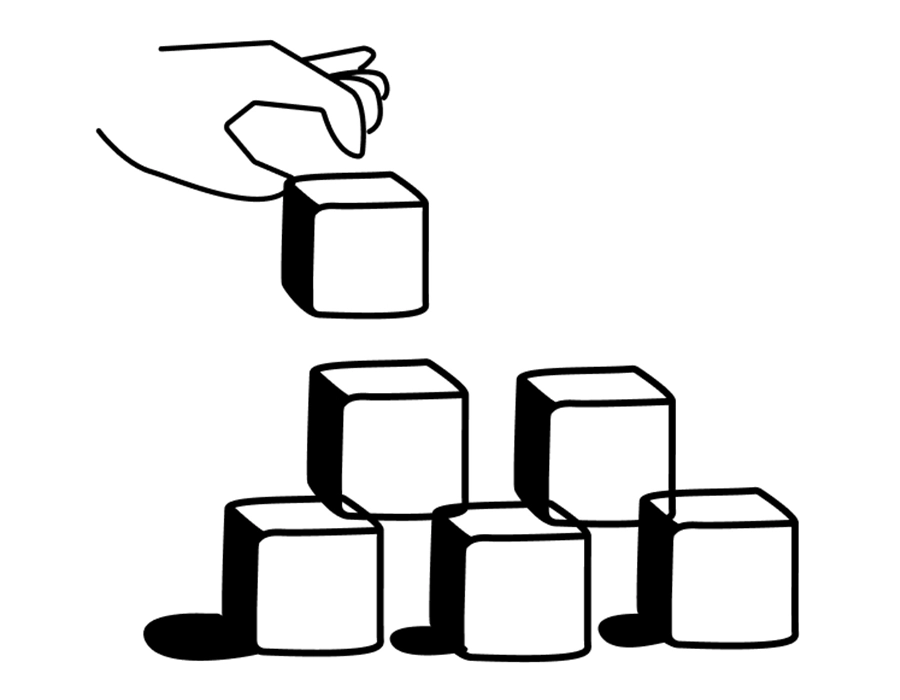Applying Leverage as a Product Manager
- April 20, 2023
- 3 Min Read
The job description for a product manager is lengthy. Be it a technical product manager, AI product manager, or anyone else who builds different products, the primary requirements remain the same. And the root of all is their team runs smoothly and delivers high-quality products. Also, they have to ensure that the product they create satisfies user requirements.
The job sounds tough, and it is. But, one of the effective ways to do this is, by applying leverage.
But, what is leverage?
In product management, leverage is the effective use of resources to maximize impact. Let’s dig deep to understand the concept of leverage further.
To learn about leverage we need to understand two important concepts. The first is about measuring managerial output. And the second talks about managerial leverage.
1. Managerial output
Simply put, the managerial output is the outcome managers produce.
A manager’s output = output of their team + output of the surrounding teams that they influence.
2. Managerial leverage
Consider there are two activities to do, Activity 1 and Activity 2. The task is to identify how to prioritize between them. Now, there are some tasks that produce more output compared to others. And, here leverage is the amount of outcome per time taken.
So, on the basis of managerial leverage, we can decide between Activity 1 and 2.

These two concepts help us figure out what matters more to us. They encourage us to think in depth about the actions we take and the impact they have on the final goal.
After understanding the importance of leverage, let us move on to the ‘how’ part.
8 key ways to apply leverage
Here are some ways in which you can apply leverage in everyday tasks.
1. Prioritizing
We have a variety of tasks on our plate (the cup runneth over!). So, it is easy to get buried under the day-to-day tasks. It makes it easier for us to disconnect from the bigger picture. Applying leverage in these situations starts with identifying high-impact tasks.
From the list of all tasks, pick out a few tasks that have the highest impact on the big picture. And then focus on completing them first.
High-priority tasks include but are not limited to:
- Defining the product vision
- Developing a roadmap
- Identifying key pain points
- Addressing key pain points
Prioritizing high-impact tasks helps in making the most of the time and resources you have. You can create a significant impact in a limited time.
But, a question arises here. How to accomplish effective prioritization?
There are various tools like the Eisenhower matrix, GTD method, etc., that help us identify priority tasks.
You can also prioritize using user data. We can collect user feedback and find out which tasks impact the user more. Tools like SurveyMonkey, Feedspace, etc., can help us collect, analyze, and manage feedback including video testimonials. This speeds up the process of taking action on the feedback we receive.
2. Utilizing individual strengths
One of the key ways to apply leverage as a product manager is by leveraging the strengths of your team.
Identify the unique skills and expertise of your team members and assign tasks accordingly. You can divide tasks based on your team's strengths to achieve high-quality results. It results in more tasks accomplished with high-quality results in less time.
Connecting with your team on a regular basis helps understand them better. Moreover, it can help you find their strengths and weaknesses which you can leverage. Regular feedback sessions and assessing past experience can also help leverage your resources.
3. Bringing in external resources
External resources can include:
- consultants,
- vendors,
- specialized tools and software, and
- collaboration with other teams within the organization.
Every team can have its limitations. And that’s where we can bring in external expertise to achieve goals.
That means, your team can work on tasks that fall under their expertise. And the external resources can focus on completing the remaining tasks.
External resources can also help you get a different perspective on your product. This can help you get a comprehensive understanding of your goals.
4. Effective communication
Miscommunication leads to errors, tons of rework, unclear direction, time waste, and more. For a team, it is crucial to be a well-oiled machine. And in order to become one, it is important to be on the same page. Effective communication helps with that.
Strong written and verbal communication helps avoid gaps in understanding. Once the team members are clear on their tasks, the end goal, and the procedure to follow, executing the task becomes easier.
It also helps us avoid constant back-and-forth between you and them which saves time. Clear communication helps in gaining clarity which helps in working faster.
Let your team know when they can connect with you. You can communicate all the necessary information to complete a task in the beginning so that they can work on it independently. This opens up your calendar to tackle other high-priority tasks.
5. Delegating
Product managers are responsible for their tasks as well as their tasks. And sometimes, they can end up working on all the tasks. It happens to many of us as we can get caught up in the details.
This is time and energy-draining for the product manager. While focusing on everything, they can lose sight of the bigger picture. Moreover, if they are working on all tasks, they cannot use the full potential of their team.
You can identify which team members can handle the task and empower them to take ownership. Once you delegate tasks your team can handle, you have time to work on tasks that fall under your expertise.
As a bonus, it increases decision-making power and knowledge sharing among the team. It makes the team more and more independent and efficient. Meaning, team members become more and more capable of handling various tasks on their own.
6. Using data
Throughout the product lifecycle, it is crucial to take actions that make your product valuable for your users. And you can make informed decisions about your product by collecting and analyzing data.
Product managers can use this data to identify and track key performance metrics. Data analytics tools can help track KPIs like user engagement, retention, revenue, etc.
Moreover, you can set up a routine of collecting user feedback and behavior analytics. Product managers can leverage this data to create functional product roadmaps.
User data can also help in making decisions about features, functionality, and improvements. Furthermore, they can also use data for risk assessment before making crucial decisions.
In a nutshell, product managers can leverage data to assess and realign their strategies based on quantifiable data. This way you can modify the product roadmap, goals, etc. well within time. It helps avoid huge repercussions and workloads in the future.
7. Collaborating with stakeholders
As a product manager, you’re not working in a vacuum. You’ll need to collaborate with a wide range of stakeholders. The stakeholders include your team, users, investors, and other departments within the organization.
Build strong relationships with these stakeholders and work together to achieve your goals. Here are some ways to ensure effective collaboration with stakeholders:
- Connecting on a regular basis for recent updates, upcoming tasks, etc.
- Sharing information and resources for recent updates, upcoming tasks, etc.
- Seeking regular feedback for recent updates, upcoming tasks, etc.
- Keeping everyone up to date for recent updates, upcoming tasks, etc.
8. Strong documentation
Documentation can become a game changer if we leverage it the right way. But on the flip side, if not done well, it is a time and resource drain. So, it is crucial to remain mindful while documenting to keep it clear and simple to understand.
Creating tutorials, onboarding videos, and more can help product managers save time. They can share these resources within the team so that they do not have to repeat the same information.
Clear, crisp, and impactful documentation will convey the message in fewer words and engage the reader.
Creating reusable valuable content avoids repetitive tasks. And, this can help you invest your resources in other unique tasks.
Moreover, effective documenting of the entire process helps us avoid making past mistakes. This way we can reduce wasting resources on redundant tasks.
Effective documentation is also a crucial aspect of asynchronous communication. It helps everyone work simultaneously without having to connect many times for small tasks.
Conclusion
The aim of applying leverage as a product manager is to scale better. The above ways can help you leverage the resources you have at hand to achieve goals faster.
Having a clear strategy and vision goes a long way in ensuring the success of a product. Thus, it is crucial to apply maximum leverage in this phase. Once we take care of these aspects, streamlining the rest of the processes becomes easier.
The concept of applying leverage may seem tough in the beginning. But, as we practice it, it becomes intuitive and enhances our efficiency.
Stay in the Know
Get ahead with TechUp Labs' productivity tips & latest tech trend resources



